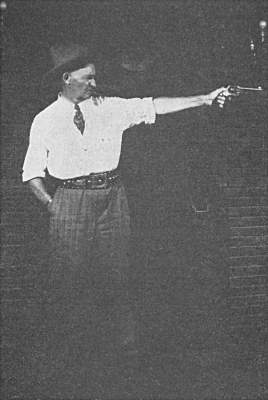The following information on left handed shooting of handguns and average scores comes from Section 12 of Shooting by J. Henry FitzGerald. Shooting is also available to purchase in print.
Much pleasure may be derived by developing the left hand in target shooting. Often the left hand after a reasonable amount of practice will deliver as good scores as the right hand. I have spent many pleasant hours in shooting the right hand against the left, for in my earlier shooting days I had very few shooting companions, for shooting thirty-five or thirty-eight years ago was not as popular as it is now. In some of these matches after thousands of shots were fired there was very little difference in the scores. I find it is easy for the right-handed shooter to change to the left hand, as one position has been worked out to his satisfaction, and it is a simple matter to apply the knowledge acquired with either hand.
I am often asked what scores the beginner should expect after a few weeks of practice. This rests in a great measure with the man himself and the kind of a weapon he has chosen. If shooting on the regulation Standard American target at twenty or fifty yards, with a .22 automatic fired at twenty yards, he should reasonably expect to be in the sixty-seventy class. All scores mentioned in this section are quoted with the understanding that the beginner has at least spent three hours each week in practice, both dry shooting and actual firing, taking extreme care with every shot. With the .38 caliber and same condition he should be in the fifty-sixty class. This is not due to the difference in accuracy of the two weapons but to the difference in recoil and a longer time is required to acquaint oneself with the arm of heavier recoil.
A properly sighted arm will add many points to a fairly good score and I know of no better way than to draw a vertical line through the center of bull’s-eye, extending to edges of target, then draw a horizontal line in the same manner. This divides the bull’s-eye into four equal parts. Count the number of hits in each quarter of the target and if light conditions and holding are normal the number of hits in each quarter should be nearly equal. Counting twenty or twenty-five targets, if the majority of hits on this number of targets should be in the two o’clock quarter for instance, the sights need a slight correction.
Do not try to correct for windage and high and low shots at the same time. Correct for high or low shots first and, when this is accomplished, correct for windage. The reason for this is that all front sights do not stand exactly straight and the raising or lowering of front sight may slightly change the group to right or left, wherein the rear sight slides on a perfectly level surface and moving it to right or left will not change the group as to height.

The front sight standing to right or left is caused in many cases by dropping the arm and also by sight being bent to right or left by the owner to accommodate some peculiarity of holding or eyesight. It sometimes happens that a revolver or pistol may be handed to several men, who are asked whether the front sight tips to right or left; part of them will see it tipped one way, while the others will see it tipped in the other direction; therefore, each individual should have his sights adjusted in a manner that will allow the front sight to appear perfectly straight to his eyes. Dividing the target as before-mentioned will aid materially in correcting the sights on any revolver or pistol and will show the necessity of a slight correction that otherwise might not be noticed. Of course the tests must be made by a person capable of grouping his shots.
At the end of six months of faithful practice the pistol enthusiast should be averaging on the twenty or twenty-five yard target between eighty and eighty-five, and with the revolver between eighty and eighty-three. The scores between eighty-five and ninety-three will come in time but the man who can average between ninety and ninety-one inside of twelve months can indeed feel that he is progressing rapidly. He must not feel that he is not progressing if after continually shooting at twenty yards his first scores at fifty yards show a decided drop in average. If matches are to be entered at fifty yards, then the practice should be at this distance and the same applies to twenty-yard shooting. If both ranges are to be shot with the same arm without sight correction the arm should be sighted for fifty yards. The average scores with pistol and revolver should show a difference of approximately three points in favor of the pistol.
